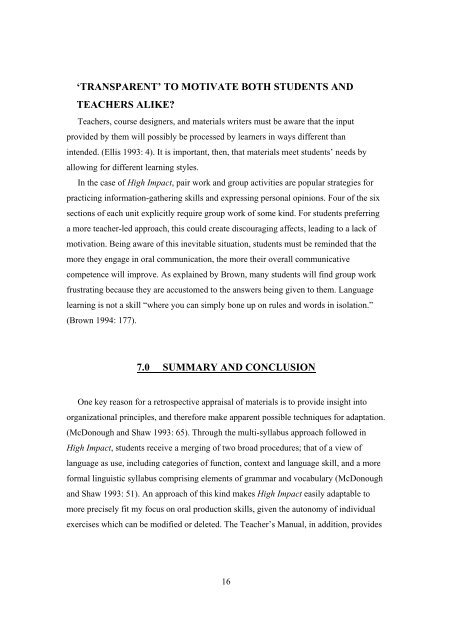A_White_COURSEBOOK_EVALUATION_syll_mat - University of ...
A_White_COURSEBOOK_EVALUATION_syll_mat - University of ...
A_White_COURSEBOOK_EVALUATION_syll_mat - University of ...
You also want an ePaper? Increase the reach of your titles
YUMPU automatically turns print PDFs into web optimized ePapers that Google loves.
‘TRANSPARENT’ TO MOTIVATE BOTH STUDENTS AND<br />
TEACHERS ALIKE?<br />
Teachers, course designers, and <strong>mat</strong>erials writers must be aware that the input<br />
provided by them will possibly be processed by learners in ways different than<br />
intended. (Ellis 1993: 4). It is important, then, that <strong>mat</strong>erials meet students’ needs by<br />
allowing for different learning styles.<br />
In the case <strong>of</strong> High Impact, pair work and group activities are popular strategies for<br />
practicing infor<strong>mat</strong>ion-gathering skills and expressing personal opinions. Four <strong>of</strong> the six<br />
sections <strong>of</strong> each unit explicitly require group work <strong>of</strong> some kind. For students preferring<br />
a more teacher-led approach, this could create discouraging affects, leading to a lack <strong>of</strong><br />
motivation. Being aware <strong>of</strong> this inevitable situation, students must be reminded that the<br />
more they engage in oral communication, the more their overall communicative<br />
competence will improve. As explained by Brown, many students will find group work<br />
frustrating because they are accustomed to the answers being given to them. Language<br />
learning is not a skill “where you can simply bone up on rules and words in isolation.”<br />
(Brown 1994: 177).<br />
7.0 SUMMARY AND CONCLUSION<br />
One key reason for a retrospective appraisal <strong>of</strong> <strong>mat</strong>erials is to provide insight into<br />
organizational principles, and therefore make apparent possible techniques for adaptation.<br />
(McDonough and Shaw 1993: 65). Through the multi-<strong>syll</strong>abus approach followed in<br />
High Impact, students receive a merging <strong>of</strong> two broad procedures; that <strong>of</strong> a view <strong>of</strong><br />
language as use, including categories <strong>of</strong> function, context and language skill, and a more<br />
formal linguistic <strong>syll</strong>abus comprising elements <strong>of</strong> grammar and vocabulary (McDonough<br />
and Shaw 1993: 51). An approach <strong>of</strong> this kind makes High Impact easily adaptable to<br />
more precisely fit my focus on oral production skills, given the autonomy <strong>of</strong> individual<br />
exercises which can be modified or deleted. The Teacher’s Manual, in addition, provides<br />
16







![Benyamin Asadipour-Farsani [EngD Conference abstract]](https://img.yumpu.com/51622940/1/184x260/benyamin-asadipour-farsani-engd-conference-abstract.jpg?quality=85)









